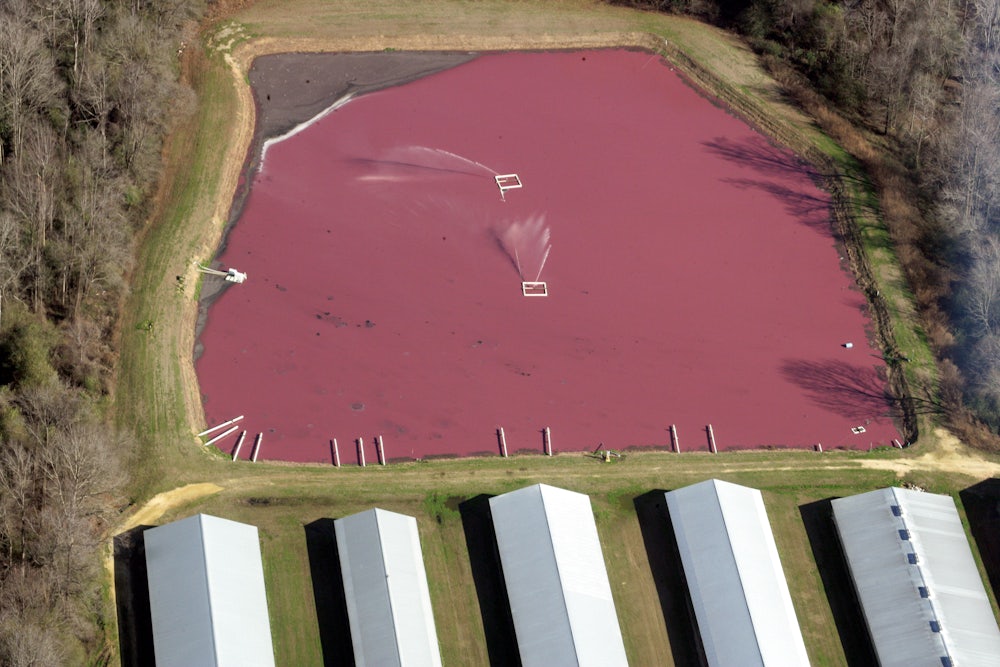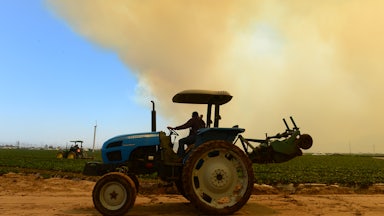Last week, the North Carolina Department of Environmental Quality officially approved the installation of biogas digesters at four Smithfield-owned hog waste lagoons in the Sampson and Duplin counties. The digesters, which capture fecal fumes to be converted to natural gas, are the result of a partnership between Smithfield and Dominion Energy, one of the partners behind the failed Atlantic Coast Pipeline. The digesters are part of what’s officially known as the Align RNG (renewable natural gas) Project; colloquially, the Grady Road Project. Environmentalists mostly hate them. To critics, the Grady Road Project shows that even as issues of emissions and environmental justice have taken center stage in recent years, companies like Smithfield, the nation’s leading pork producer, have only fortified their position in the region, staving off meaningful reform with the help of state agencies—and, as fate would have it, a couple of Biden Cabinet members.
In the coming decade, Smithfield plans to cover 90 percent of its hog waste lagoons with these anaerobic digesters. The digesters capture the methane, which in the Grady Road Project’s case will then be transported via a new Dominion pipeline to an off-site facility, where it will be converted to natural gas and then used in Dominion’s existing pipeline infrastructure. Duke Energy has already enacted similar plans in the region. The digesters—and biofuels more broadly—are a key part of an attempt by the agriculture and gas industries to cash in on the current push for short-term energy solutions. The mass production of pork results in an ungodly amount of feces and methane emissions; the companies want to channel the methane into another income stream. But while the anaerobic technology does help extract more value from the enterprise, ultimately it still releases greenhouse gas into the air, and it doesn’t solve any of the local pollution problems caused by the hog farms. As usual, marginalized communities in the area are facing a double team of state regulators and private interests.
Duke, Dominion, and Smithfield are all predictably bullish on the potential of biogas and have spent the past few years talking it up to anyone who will listen. They don’t talk as much about what these hog farms do with the leftover feces. As Blakely Hildebrand, an attorney with the Southern Environmental Law Center, told North Carolina Health News in 2019, “Biogas technology that doesn’t address water pollution and public health issues associated with industrial-scale hog production is not a complete solution.”
See, after the digesters have done their work and extracted the available methane, what’s left of the waste, or liquefied pig shit and urine, is then used in Smithfield’s sprayfield system, wherein it is misted over crops and fields as a fertilizer. This leaves neighbors—who, in this part of the state, are often a combination of low-income, Black, Latinx, and Native families—with few options but to shut their windows; hold their nose; and pray that their yards, gardens, and groundwater wells go uncontaminated. If the majority of the hog farms in North Carolina were clustered in the western part of the state, there might be fewer—albeit still pressing—concerns. But they’re not. The farms in Sampson and Duplin counties that Smithfield has claimed for itself sit on low-lying, coastal-adjacent lands. So in 2018, when Hurricane Florence ripped through the East Coast, over 100 lagoons were flooded, sending the mix of feces, urine, and anaerobic bacteria over the lagoon walls. The same happened with Hurricane Floyd in 1999.
Even without the risk from hurricanes, these facilities present risks to the health and life expectancy of nearby residents. In 2018, a Duke University study published in North Carolina Medical Journal found that, while it could not prove causality, communities living in zip codes near these operations posted “higher rates of all-cause mortality, infant mortality, mortality of patients with multimorbidity, mortality from anemia, kidney disease, tuberculosis, and septicemia.” And while the new digester systems will marginally mitigate methane emissions, there’s evidence that capping the ponds will result in “higher concentrations of ammonia in the sprayed waste,” as a group of Democratic lawmakers in North Carolina wrote when petitioning the Department of Environmental Quality in January to reject the application for water quality permits. And let’s be clear: The fuel produced by this scheme still releases gas that warms the planet. A proposal to burn poop just because it’s there is not the same thing as installing a wind farm.
As the Duke University study pointed out, the population density in Sampson and Duplin counties is “substantially higher” than in areas of Iowa and Minnesota featuring a similar number of large-scale industrial hog farms. So there are significantly more people at risk. The study also found that the number of low-income, uninsured, Black and Native households living near hog farms vastly exceeded those in its control group. In short, hog farms, as currently constituted in North Carolina, remain one of the most blatant forms of environmental racism that exist in this nation.
This makes it all the more vexing that two current Cabinet members—U.S. Department of Agriculture Secretary Tom Vilsack and Environmental Protection Agency Secretary Michael Regan—have tacitly and explicitly co-signed the use of biofuels, both throughout their careers and in recent months. In the case of Regan, who moved to the EPA from his post as director of the North Carolina DEQ, he was in office when the DEQ was approving permits for Smithfield and Dominion’s Grady Road Project. (The USDA did not respond to The New Republic’s request for comment, while the EPA pointed TNR to the North Carolina DEQ and did not respond to questions about the EPA’s stance on regulating lagoons and biofuels by publication.)
Before, during, and after his Senate confirmation hearings, Regan repeatedly said his own experience as a Black citizen from eastern North Carolina had affected his understanding of a regulator’s responsibilities with regard to environmental justice. As the head of the DEQ, he created the North Carolina Environmental Justice and Equity Board and spearheaded efforts to hold Duke Energy accountable in the fallout of its coal ash spills. He also resisted efforts by North Carolina Republicans to place a cap on the amount of relief that residents can receive from nuisance lawsuits against polluting farms, and slapped Smithfield contractors whose lagoons leaked due to mismanagement with five-figure fines. And just last Wednesday, Regan issued a memo to the entire EPA staff, instructing them to “examine, and appropriately use, the full array of policy and legal tools at our disposal to incorporate environmental and climate justice considerations.”
In theory, therefore, Regan is one of the best-prepared EPA chiefs in history to make the agency more aware of environmental justice issues. But, as environmentalists in North Carolina pointed out following his EPA nomination, it’s also true that Regan’s appointment to the EPA was met with glowing praise by the National Pork Producers Council, who found that while leading the DEQ, Regan had an “open door” for the industry. Although he cracked down on leaking lagoons, as E&E News reported in December, he did little to block permits for farms with outdated manure management systems like those that still litter Sampson and Duplin counties. While hog farmers learned not to act as recklessly during his tenure, the lagoon and sprayfield systems at the center of the industry’s environmental issues emerged largely unchanged. And now, Smithfield is able to move full-steam ahead with its plans to carve out more lagoons, so it can pump more biofuel in Duke and Dominion pipelines.
As for Vilsack, it’s been clear for years that the former Obama-era USDA secretary isn’t interested in seriously reforming American agriculture. In the Obama years, Vilsack’s department made millions available in grants for farms looking to introduce anaerobic digesters. In his Senate confirmation hearings in February, Vilsack repeatedly issued his vote of confidence in biofuels as a form of clean energy that the federal government should encourage the agriculture industry to undertake. That’s consistent with his prior ties to Iowa, where both hog and corn producers are looking to capitalize on biofuels. He’s since doubled down on this stance, commenting at a recent conference that he expects biofuels to be an integral part of extending the lifespan of combustion-engine automobiles through the coming decades.
As with natural gas produced by fracking, the idea that biofuels can be produced without causing very real harm to marginalized communities is one that should have been laughed off the stage years ago. Instead, as the modern agriculture industry looks to the future, it has, much like its gas and oil counterparts, determined that the best route forward is the short-term plan that nets it the most cash and federal grants possible. Regan’s past actions do leave the door open for his EPA to more stringently regulate how hog farms and others manage their waste. But if governmental agencies across the board continue enabling and encouraging the nation’s reliance on natural gas, then the spot we’ll be in five decades from now will feel eerily similar to both the past and our current moment: with a select few corporations reaping all the benefits, and Black, Native, and Latinx communities paying for the marginal gains with literal years off their lives.








